Eastern Region Viewing Area
LOCATION and PHOTOS
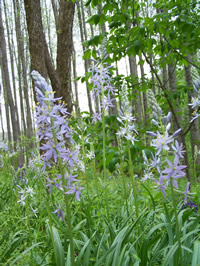 Wild hyacinth (Camassia scilloides). Photo by Teena Ligman.
Wild hyacinth (Camassia scilloides). Photo by Teena Ligman.
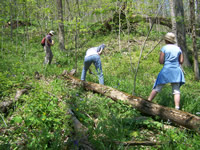 Wildflower Foray hikers. Photo by Teena Ligman.
Wildflower Foray hikers. Photo by Teena Ligman.
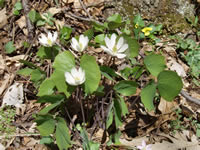 Twinleaf (Jeffersonia diphylla). Photo by Kirk W. Larson.
Twinleaf (Jeffersonia diphylla). Photo by Kirk W. Larson.
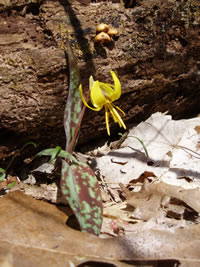 Yellow trout lily (Erythronium americanum). Photo by Kirk W. Larson.
Yellow trout lily (Erythronium americanum). Photo by Kirk W. Larson.
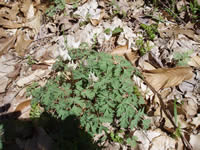 Dutchman’s-breeches (Dicentra cucullaria). Photo by Kirk W. Larson.
Dutchman’s-breeches (Dicentra cucullaria). Photo by Kirk W. Larson.
Wild Hyacinths in the Charles C. Deam Wilderness
Forest: Hoosier National Forest
District: Brownstown Ranger District
Description: Each spring a small corner of the Charles C. Deam Wilderness on the Hoosier National Forest provides a gorgeous display of pale blue wildflowers. This area has a rich flora of spring wildflowers due to its close proximity to a geologic feature known as the Mount Carmel Fault. Wild hyacinths and twinleaf dominate the area, but a closer look rewards visitors with a delightful display of many more spring wildflowers. Plan to come early in the year as many wildflowers such as twinleaf and trout lily begin blooming in March to early April. The wild hyacinths flower a short time later during late April and early May. Other areas of the wilderness provide visitors a multi-seasonal opportunity for hiking, camping, bike riding, wildlife and wildflower viewing over an extensive trail system. The Forest requires trail permits of horseback riders over 16 years of age. Visitors can purchase permits either annually or on a daily basis. Additionally, group size is limited to 10 persons or less.
Viewing Information: The more abundant and showy plants in the area include wild hyacinth, twin leaf, bloodroot, dutchman’s-breeches, Jacob’s-ladder, trillium, firepink, draft larkspur, phacelia, jack-in-the-pulpit, wood poppy, blue phlox, trout lily, buttercup, spring beauty, and violet. Common mammals include white-tailed deer, turkey, raccoon, and fox squirrels. Birds observed within the wilderness include pileated woodpecker, sharp-shinned hawk, red-shoulder hawk, broad-winged hawk, wood thrush, scarlet tanager, several warbler species, and bald eagle.
Safety First: Visitors can view a dense display of hyacinths and other wildflowers from the Hunter Creek Road on southwest corner of the Charles C Deam Wilderness. For a closer look, visitors must proceed uphill on a steep, but short hike or go side hill from the small parking area across from the Mitchell Cemetery. If proceeding off the roadside, please use caution on steep slopes. Beware of slippery rocks when crossing creeks. Always carry a snack, insect repellant, water and a light raincoat, and wear (comfortable) hiking boots when hiking. As part of the annual Brown County’s Spring Wildflower Foray, Forest Service personnel have led hikers to this area for several years during the third week in April.
Directions: From I-64, take IN Highway 37 proceeding north to Bedford, Indiana. Go east on US 50 about 8 miles to IN 446. An alternate route to IN 446 is by heading west from I-65 through Seymour, IN on US 50 for about 29 miles. After reaching IN 446, go north for approximately 8 miles to the Hunter Creek Road. Turn right crossing Little Salt Creek traveling east for about ½ mile to the first gravel road heading north to the Mitchell Cemetery. Go north for less than ¼ mile to a small parking area across from the cemetery. The wild hyacinth site is back to the southwest on the south-facing hillside at the far corner of the wilderness. A small creek is directly west of the parking area.
Ownership and Management: U.S. Forest Service, Hoosier National Forest, Brownstown Ranger District. For more information, contact the Brownstown Ranger District/Forest Headquarters Office at (812) 275-5987.
Closest Town: Heltonsville and Bloomington, Indiana.

